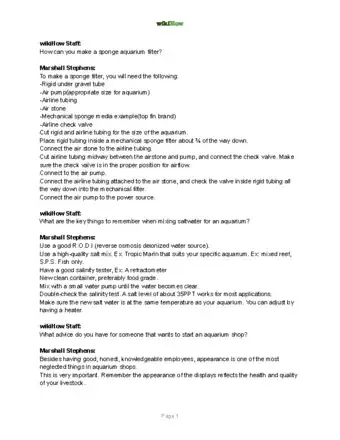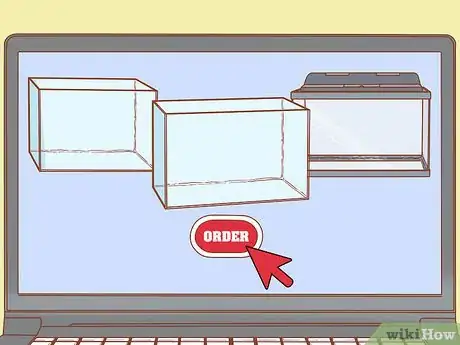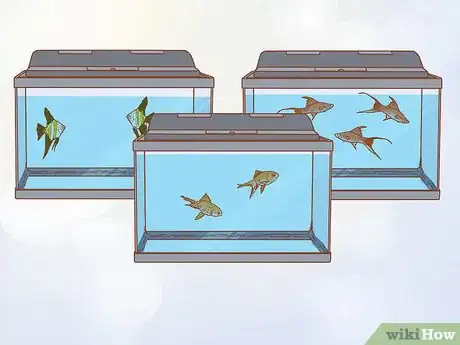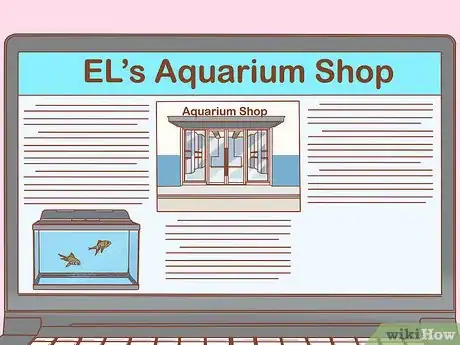This article was co-authored by Marshall Stephens. Marshall Stephens is an Aquarium Expert at Private Oceans Aquariums in West Palm Beach, Florida. Marshall has over 20 years of experience in the aquarium industry and focuses on captive-bred animals. They specialize in tropical and marine aquariums and are a contributor to the Loggerhead Marine life center in Jupiter Florida.
There are 8 references cited in this article, which can be found at the bottom of the page.
wikiHow marks an article as reader-approved once it receives enough positive feedback. In this case, 98% of readers who voted found the article helpful, earning it our reader-approved status.
This article has been viewed 170,365 times.
If you’re a fan of fish or aquariums and want to start your own business, you may want to open up an aquarium shop. Fish and aquarium shops can be pretty lucrative, provided you go about planning, stocking, and running your business the right way. With a little determination, creativity, and forethought, you can turn your business idea into a successful aquarium shop in no time!
Steps
Planning and Establishing Your Business
-
1Create a detailed, goal-oriented business plan for your shop. Write out what the short- and long-term plans for your company are in terms of appealing to customers, turning a profit, and expanding, if applicable. This will help you predict any hiccups you might experience in starting your business, such as figuring out how to secure funding or what area of town is the best location for your business.[1]
- Traditionally, business plans are broken down into some combination of these 9 nine sections: executive summary, company description, market analysis, organization and management, service or product line, marketing, funding, financial projections, and appendix.
- Be as detailed in your plan as possible. Make a list of the smaller details about your business, such as owner’s and employees’ responsibilities, the types of services you’ll provide, and what prices you intend to offer your products at.
-
2Research the competition to figure out where you can fit in the market. To maximize your chances of success, you’ll need to determine what you can offer in your aquarium shop that customers in your area can’t get from your competitors. Visit other aquarium shops to see what products and services they sell, what prices they offer, and other relevant aspects of their businesses.[2]
- Another good way to do this type of research is to learn what leading aquarium shops are doing, then figure out how you could do it better. For example, if a major aquarium shop offers free next-day installation, see if your store can offer free same-day installation.
Advertisement -
3Obtain any necessary licenses, certificates, and insurance. Check with your state and local governments to learn what types of licenses and certificates your business will be required to have. Because you’ll be working with animals, your shop will also be subject to any animal welfare laws that exist where you’re located.[3]
- For example, if your aquarium shop is located in the United States, it is required to be licensed under the Animal Welfare Act.
- If you’re unsure what licenses, certificates, or insurance you’ll need, you may want to hire a business attorney who can help guide you through these legal questions. Ideally, try to hire one with experience working with pet stores.
-
4Find a suitable empty store or lot to establish your shop. It may seem counterintuitive, but you’ll want to look for an available storefront as close to your biggest competitor as possible, in order to take advantage of the foot traffic that their store generates. Plus, if they’re successful, it’s probably due in part to their location, which means placing your store in the same location should also help your shop.[4]
- You may not want to be directly next to your competitor, since customers may consistently choose your competitor’s store over yours. However, you should aim to be in the same shopping center or area of town, if you can.
- If you’re planning to only sell materials online, you don’t need to worry so much about where your store or warehouse is located.
-
5Purchase anything you’ll need to be able to run your business. This may include cash registers, store cleaning supplies, or even light bulbs. You can acquire most of these items from a small business wholesaler in your area.[5]
- You might also be able to buy some of these items, such as cleaning supplies, online or from a mass retailer.
-
6Hire workers to staff your shop, if necessary. Unless you plan to do all the work running the store by yourself or within your family, you’ll probably need to bring on some extra staff. Hire these workers before you actually open your store for business, so you can hit the ground running.[6]
- For best results, try to hire workers who have previous experience working in aquarium shops.
Stocking Your Aquarium Shop
-
1Look for a distributor in your region who you can buy supplies from. You can simply search online for your city, region, or state, along with the words “aquarium” and “distributor” to find a supplier in your area. Although buying your stock from a distributor is a tad more expensive than buying it directly from the manufacturer, a distributor will fill smaller orders (like for a small business) where manufacturers often will not.[7]
- Distributors are also sometimes called wholesalers, brokers, or jobbers.
- You can also ask your competitors who they get their supplies from, although they probably won’t be too keen to help you.
-
2Order fish tanks, parts, and other accessories to stock your shop with. You’ll need to secure supplies of tanks and tank lids, stands, filtration and aeration systems, water treatment systems, tank scrubbers, decor, and anything else that a potential customer might need for their aquarium. Place a small order with your wholesaler at first to get a sense of how much product you can move in a set amount of time.[8]
-
3Purchase a variety of fish types to sell to a wider market. You won’t be able to turn as much of a profit by sticking to 1 or 2 types of fish, like guppies or goldfish. By selling more exotic species as well, you will not only appeal to a broader clientele, but will also be able to sell more valuable (and profitable) items.[9]
- You can acquire your fish either from saltwater fish collectors, who capture the fish in the wild, or from freshwater fish farms.
- Note that you’ll need to know how to take care of exotic fish before you can buy them and sell them in your store. Examples of exotic fish to stock in your store may include African cichlids, angelfish, or swordtails.
- You should also aim to stock both freshwater and saltwater fish. Although most home aquariums house freshwater fish, you’ll want to make sure you’re catering to as many potential customers as possible.
-
4Take good care of the fish while they’re in your possession. The fish aren’t just your means of making an income; they’re also living creatures that need to be taken care of. Be sure you’re adequately feeding and housing the fish you’re selling and monitor their health for any signs of illness.[10]
- Make sure you feed the fish the right type of food each day. For example, some species of fish eat tropical flakes, while others eat bloodworms, while still others eat shrimp eggs and krill.
- Measure the pH levels in the tank each week to make sure they’re within an acceptable range for the type of fish in the aquarium.
- Clean each aquarium each week and replace the filter every month.
Marketing and Advertising Your Business
-
1Consider using innovative ways to get customers in the door. For example, hold a grand opening on the day you establish your store and offer buy-one-get-one coupons for patrons. You can also experiment with rewards programs and discount days to see what works best for generating foot traffic in your shop.[11]
- If your competitors offer a particular incentive for their customers, try to outmatch them. For instance, if they offer a buy-one-get-one deal, create a buy-one-get-two program to steal their customers.
- Appearance is one of the most neglected aspects of aquarium shops. Remember that the appearance of displays reflects the health and quality of your livestock, so make sure to focus on that.
-
2Post advertisements for your new shop to let people know about you. Place your ads where the most people will see them, even if it’s the more expensive option. Although an ad spot in a print newspaper may be cheaper, it won’t be as effective at bringing in customers as an Internet ad.[12]
- The same goes for radio ads versus television commercials.
-
3Create a website for your store to build your online presence. Use search engine optimization (SEO) strategies to make your website appear near the top of Internet searches for aquarium shops in your area. Then, keep your online presence active and engaging by interacting with people on social media and posting frequent updates about your store.[13]
- Remember, people won’t be as interested in your website if it never gets updated.
- Be innovative in how you cultivate your online presence. For example, consider posting fun videos about your store to YouTube and other social media websites to get people talking about you.
Community Q&A
-
QuestionWhere can I buy fish for my business?
 Community AnswerYou can contact a local breeder or breed your own fish. There are also many websites online where you can order fish.
Community AnswerYou can contact a local breeder or breed your own fish. There are also many websites online where you can order fish. -
QuestionIs it possible to start a fish shop with only one breed of fish?
 Community AnswerYes, but it would have to be an incredibly popular and appealing fish or else you wouldn't have enough of a profit to make it worthwhile.
Community AnswerYes, but it would have to be an incredibly popular and appealing fish or else you wouldn't have enough of a profit to make it worthwhile. -
QuestionWhat type of water do I use in the tanks?
 NickCommunity AnswerIt depends on what type of fish you are buying to sell. If you are buying both saltwater and freshwater then you will want to have your fish tanks set up where all of the freshwater on a level is flowing together while the saltwater on that level is flowing with only other saltwater. To have the water flow between tanks you will want to create small oval shaped holes at the bottom and top of each piece of acrylic separating the different types of fish so that the water can flow freely from tank to tank.
NickCommunity AnswerIt depends on what type of fish you are buying to sell. If you are buying both saltwater and freshwater then you will want to have your fish tanks set up where all of the freshwater on a level is flowing together while the saltwater on that level is flowing with only other saltwater. To have the water flow between tanks you will want to create small oval shaped holes at the bottom and top of each piece of acrylic separating the different types of fish so that the water can flow freely from tank to tank.
Warnings
- Maintaining healthy fish is harder than it looks! Learn as much as you can about housing and feeding fish before you start your aquarium shop.⧼thumbs_response⧽
- Consider investing in an advanced security system for your store. Small shops are more likely to be targeted by burglars than big, name-brand stores.⧼thumbs_response⧽
- Be advised that starting up a new aquarium shop, or any business, requires a good bit of money, time, and energy. Don’t jump into launching a new business without making sure you have these supplies first.⧼thumbs_response⧽
Expert Interview

Thanks for reading our article! If you'd like to learn more about aquariums, check out our in-depth interview with Marshall Stephens.
References
- ↑ https://www.sba.gov/business-guide/plan-your-business/write-your-business-plan
- ↑ http://www.gaebler.com/How-to-Start-an-Aquarium-Business.htm
- ↑ https://nextwhatbusiness.com/fish-aquarium-business-plan/
- ↑ https://www.entrepreneur.com/article/73784
- ↑ https://smallbiztrends.com/2015/10/opening-your-first-retail-store.html
- ↑ https://howtostartanllc.com/business-ideas/pet-fish-store#getting-started
- ↑ https://www.entrepreneur.com/article/66028
- ↑ https://nextwhatbusiness.com/fish-aquarium-business-plan/
- ↑ https://howtostartanllc.com/business-ideas/pet-fish-store#getting-started
- ↑ http://www.gaebler.com/How-to-Start-an-Aquarium-Business.htm
- ↑ https://howtostartanllc.com/business-ideas/pet-fish-store#getting-started
- ↑ https://howtostartanllc.com/business-ideas/pet-fish-store#getting-started
- ↑ https://www.forbes.com/sites/forbestechcouncil/2018/04/20/how-to-create-a-big-online-presence-for-your-small-business/#6694d1ca6c34
About This Article
To start an aquarium shop, first you'll need to obtain the necessary licenses, certificates, and insurance for your area since you'll be operating a business and working with animals. Then, you can rent a space to run your shop out of and stock it with all the equipment and products you'll need, like cash registers, fish tanks, and aquarium accessories. You'll also want to find a local fish collector to purchase a variety of fish types from. To learn how to advertise your aquarium shop, scroll down!











































































